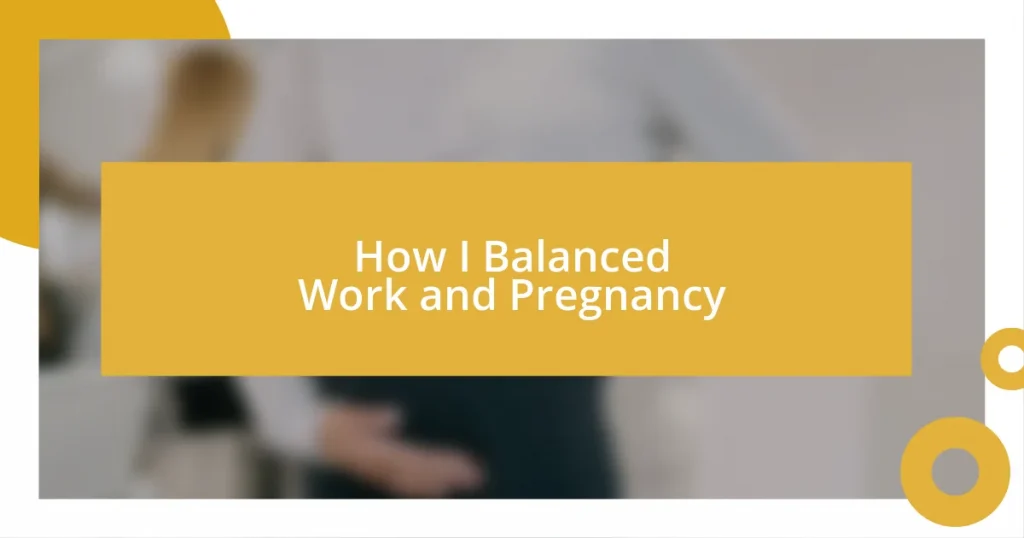Key takeaways:
- Open communication with supervisors and colleagues is essential for balancing work and pregnancy, fostering understanding and support.
- Creating a flexible work schedule and prioritizing self-care can significantly enhance productivity and wellbeing during pregnancy.
- Establishing a supportive network with other parents at work helps in navigating shared challenges and eases the transition back after maternity leave.

Understanding Work and Pregnancy
Balancing work and pregnancy is an intricate dance that many expectant mothers navigate daily. I remember standing in front of my closet one morning, feeling overwhelmed by the choice between professional attire and comfortable maternity wear. I often wondered, “How do I project that I’m still capable at my job while managing these physical changes?” It was a delicate balance of identity.
As my pregnancy progressed, the challenges evolved, from fatigue to the emotional rollercoaster that can accompany these nine months. I found myself yearning for understanding from my colleagues, often asking, “Do they truly grasp what I’m experiencing?” It struck me how essential it is for workplaces to foster open communication, allowing pregnant women the space to share their needs without fear of judgment or stigma.
I learned that it’s not just about managing responsibilities; it’s about accepting support and understanding one’s limits. It’s okay to ask for that extra time during a project, and I sometimes had to remind myself that prioritizing rest today would ultimately benefit my performance tomorrow. Embracing that mindset shifted my perspective and made navigating work during pregnancy feel a bit less daunting.

Preparing for Pregnancy at Work
Preparing for pregnancy at work is a journey that involves thoughtful planning and candid conversations. Early on, I realized that my workload might need adjustments, so I discreetly initiated discussions with my supervisor about how to balance my responsibilities. I remember the sigh of relief when we mapped out a flexible schedule. It made me feel supported, and it empowered me to approach my pregnancy with confidence rather than anxiety.
Here are some practical steps that helped me prepare for pregnancy at work:
- Communicate Early: Talk with your supervisor to discuss adjustments that might be beneficial for you and the team.
- Organize Your Tasks: Prioritize your workload, focusing on key projects that matter most before you may need to transition into maternity leave.
- Create a Support Network: Connect with other working mothers for advice and encouragement.
- Know Your Rights: Familiarize yourself with workplace policies regarding maternity leave and any accommodations you might need.
- Self-Care Matters: Schedule time for breaks and self-care throughout the day to manage fatigue and stress.
Finding balance is a personal endeavor, and it’s crucial to trust your instincts while also seeking support from your colleagues and friends. After sharing my needs with the team, the camaraderie we built made a significant difference in how I felt during my pregnancy. It’s amazing how much lighter the load feels when you know others are in your corner.

Communicating with Employers
Navigating the conversation with employers during pregnancy is an essential aspect of maintaining balance. I recall preparing for my first meeting with my boss; my heart raced as I knew this discussion could set the tone for the coming months. When I finally opened up about my pregnancy, I felt a surprisingly heavy weight lift off my shoulders. It was a moment of vulnerability that ultimately fostered understanding and support, not just from my manager, but also from my colleagues as they learned to adapt to my needs.
Being upfront about your condition creates an environment of transparency. I found that regularly updating my employer about my health and workload allowed us to collaboratively adjust expectations. This proactive approach created a space where I felt not only heard but also valued as an employee, and it transformed the overall dynamics in the office. It’s remarkable how honest communication can lead to more flexibility and create a supportive atmosphere.
I also discovered that sharing my feelings about pregnancy with my team during informal check-ins encouraged them to express their thoughts and support as well. I remember one instance where a colleague surprised me with an offer to help with a project I was juggling. I think these moments of shared understanding are crucial. They show that when we open the door to dialogue, we build a stronger community around our work.
| Key Communication Steps | Benefits |
|---|---|
| Initiate early discussions | Sets a positive tone and reduces anxiety |
| Provide regular updates | Maintains trust and aligns expectations |
| Share personal feelings | Encourages empathy and teamwork |

Managing Workload During Pregnancy
Managing my workload during pregnancy required a delicate balance of planning and prioritization. I found that breaking my tasks into manageable chunks not only reduced stress but also helped me stay focused on what truly mattered. For instance, I made a habit of listing my top three priorities for the day each morning. Have you ever tried this approach? It felt liberating to have a clear direction, allowing me to effectively navigate the demands of my job while honoring my changing body and needs.
As my pregnancy progressed, I recognized that my energy levels fluctuated. Some days, I could tackle projects with zeal, while others felt like an uphill battle. During those tougher days, I learned to communicate my needs openly with my supervisor. I remember one particularly exhausting week when I asked for lighter assignments. To my surprise, my boss not only understood but offered me an adjusted workload that allowed me to take on smaller, more focused tasks. In hindsight, this exchange reminded me of the importance of being transparent about my capacity—it opened doors to support I never anticipated.
I also formed a strong connection with colleagues who were also parents. Their stories shared over coffee breaks became a lifeline. One afternoon, a co-worker shared how she had juggled her responsibilities during her pregnancy, and I could feel a wave of relief wash over me. It made me realize that I wasn’t alone in this journey. Building that community not only bolstered my confidence but also enriched my experience at work. Do you have a support network at work? It truly makes a world of difference when you can lean on others who understand what you’re going through.

Prioritizing Health and Wellbeing
Prioritizing health and wellbeing during pregnancy was an absolute game-changer for me. I truly recognized that carving out time for self-care wasn’t just a luxury; it was a necessity. I made it a point to schedule short, rejuvenating breaks throughout my workday. Some days, a simple walk outside or a few moments focused on breathing made all the difference in how I felt both physically and mentally. Have you ever noticed how a bit of fresh air can reset your day?
Listening to my body became essential. There were days when I felt invincible, but others when just getting out of bed required monumental effort. I recall one week when fatigue hit me like a ton of bricks, and instead of pushing through, I decided to take a mental health day. That single day off permitted me to recharge—not just physically but emotionally too. It’s a lesson I often reflect on: prioritizing our wellbeing isn’t an indulgence; it’s fundamentally about maintaining balance in our lives.
Nutrition also played a critical role in how I navigated work and pregnancy. Early on, I learned that fueling my body with the right foods directly impacted my energy levels and mood. I started packing nutritious snacks—like almonds and carrots—into my bag, and the difference was remarkable. I’ve found that when I care for my body, I’m more productive and engaged, which creates a ripple effect that benefits not just me but my coworkers as well. Think about it: when was the last time you felt amazing after a wholesome meal? There’s real power in taking care of ourselves, and it became a priority I’ve continued to uphold long after my pregnancy.

Creating a Flexible Schedule
Establishing a flexible schedule was crucial for me during my pregnancy. I vividly remember the day I rearranged my work hours to start an hour earlier. This adjustment allowed me to finish my tasks while still having the afternoons open for rest. Have you ever considered how shifting your routine slightly can create a better balance? It felt liberating, like I was reclaiming a bit of control over my day.
In addition to adjusting my daily clock, I also learned the value of being spontaneous. Some mornings, I woke up feeling sluggish, and rather than forcing myself into a rigid plan, I embraced the idea of working from home when needed. I recall a particularly dreary Tuesday when I called in to say I’d be tackling my tasks from the comfort of my couch. That day, I was surprised by how much more productive I was in a relaxed environment, able to pause whenever I needed a breather. It’s amazing how a little flexibility can spark creativity and motivation, isn’t it?
I found that setting boundaries around my work hours was just as important as being flexible. There were moments when I had to remind myself that it was okay to leave work at work. I used to check emails late into the evening until I realized the toll it was taking on my overall wellbeing. By establishing a firm cut-off time for work, I created the mental space necessary to unwind and focus on self-care. Have you ever tried to “switch off” completely? It’s a practice that, once adopted, gave me peace of mind, allowing me to enjoy my evenings while looking forward to each workday.

Returning to Work After Maternity
Returning to work after maternity leave was a bittersweet experience for me. The excitement of re-engaging with my career mingled with an overwhelming sense of apprehension. I remember bursting into tears the night before my first day back, torn between the joy of seeing my colleagues and the heartache of leaving my little one behind. Have you ever experienced that mix of anticipation and anxiety? It’s a rollercoaster of emotions that many new parents navigate.
On my first day back, I tried to keep things light. I brought along a photo of my baby to share with my colleagues. It sparked conversations and laughter, which made me feel welcomed and less isolated in my new role as both a mother and a professional. It’s fascinating how sharing a bit of your world can forge connections, don’t you think? Those small moments of openness helped me transition back into the workplace more smoothly than I’d expected.
As the weeks went by, I learned that communication was key. I made it a point to express my feelings, whether it was sharing my struggles with pumping at work or asking for adjustments to my schedule. I found camaraderie among other parents, which really reassured me. When was the last time you connected with someone over a shared challenge? I discovered that being open not only lightened my emotional load but also built a supportive network that empowered me to balance my new responsibilities effectively.














